Related Research Articles
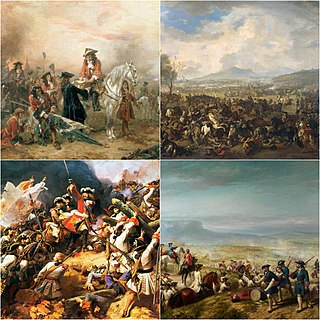
The War of the Spanish Succession was a European great power conflict fought between 1701 and 1714. The immediate cause was the death of the childless Charles II of Spain in November 1700, which led to a struggle for control of the Spanish Empire among supporters of the claimant Bourbon and Habsburg dynasties. His official heir was Philip of Anjou, a grandson of Louis XIV of France, whose main backers were France and most of Spain. His rival, Archduke Charles of Austria, was supported by the Grand Alliance, whose primary members included Austria, the Dutch Republic, and Great Britain. Significant related conflicts include the 1700 to 1721 Great Northern War, and Queen Anne's War in North America.

Catherine II, most commonly known as Catherine the Great, was the reigning empress of Russia from 1762 to 1796. She came to power after overthrowing her husband, Peter III. Under her long reign, inspired by the ideas of the Enlightenment, Russia experienced a renaissance of culture and sciences, which led to the founding of many new cities, universities, public libraries and theatres. At that time Russia became the new homeland for hundreds of thousands of European immigrants, and became recognized as one of the great powers of Europe.

The Great Northern War (1700–1721) was a conflict in which a coalition led by the Tsardom of Russia successfully contested the supremacy of the Swedish Empire in Northern, Central and Eastern Europe. The initial leaders of the anti-Swedish alliance were Peter I of Russia, Frederick IV of Denmark–Norway and Augustus II the Strong of Saxony–Poland–Lithuania. Frederick IV and Augustus II were defeated by Sweden, under Charles XII, and forced out of the alliance in 1700 and 1706 respectively, but rejoined it in 1709 after the defeat of Charles XII at the Battle of Poltava. George I of Great Britain and the Electorate of Hanover joined the coalition in 1714 for Hanover and in 1717 for Britain, and Frederick William I of Brandenburg-Prussia joined it in 1715.
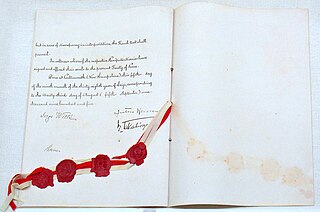
The Treaty of Portsmouth is a treaty that formally ended the 1904–1905 Russo-Japanese War. It was signed on September 5, 1905, after negotiations from August 6 to August 30, at the Portsmouth Naval Shipyard in Kittery, Maine, United States. U.S. President Theodore Roosevelt was instrumental in the negotiations and won the Nobel Peace Prize for his efforts, the first ever American recipient.
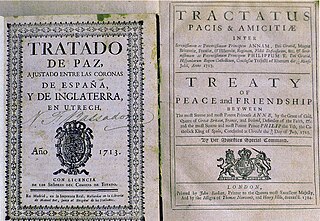
The Peace of Utrecht was a series of peace treaties signed by the belligerents in the War of the Spanish Succession, in the Dutch city of Utrecht between April 1713 and February 1715. The war involved three contenders for the vacant throne of Spain, and involved much of Europe for over a decade. The main action saw France as the defender of Spain against a multinational coalition. The war was very expensive and bloody, and finally stalemated. Essentially, the treaties allowed Philip V to keep the Spanish throne in return for permanently renouncing his claim to the French throne, along with other necessary guarantees that would ensure that France and Spain should not merge, thus preserving the balance of power in Europe.

The Treaty of Berlin was signed on 13 July 1878. In the aftermath of the Russian victory against the Ottoman Empire in the Russo-Turkish War of 1877–1878, the major powers restructured the map of the Balkan region. They reversed some of the extreme gains claimed by Russia in the preliminary Treaty of San Stefano, but the Ottomans lost their major holdings in Europe. It was one of three major peace agreements in the period after the 1815 Congress of Vienna. It was the final act of the Congress of Berlin and included Great Britain and Ireland, Austria-Hungary, France, Germany, Italy, Russia and the Ottoman Empire. Chancellor of Germany Otto von Bismarck was the chairman and dominant personality.

The Russo-Ottoman War of 1710–1711, also known as the Pruth River Campaign, was a brief military conflict between the Tsardom of Russia and the Ottoman Empire. The main battle took place during 18–22 July 1711 in the basin of the Pruth river near Stănilești after Tsar Peter I entered the Ottoman vassal Principality of Moldavia, following the Ottoman Empire’s declaration of war on Russia. The ill-prepared 38,000 Russians with 5,000 Moldavians, found themselves surrounded by the Ottoman Army under Grand Vizier Baltacı Mehmet Pasha. After three days of fighting and heavy casualties the Tsar and his army were allowed to withdraw after agreeing to abandon the fortress of Azov and its surrounding territory. The Ottoman victory led to the Treaty of the Pruth which was confirmed by the Treaty of Adrianople.

The Treaty of Turkmenchay was an agreement between Qajar Iran and the Russian Empire, which concluded the Russo-Persian War (1826–1828). It was second of the series of treaties signed between Qajar Iran and Imperial Russia that forced Persia to cede or recognize Russian influence over the territories that formerly were part of Iran.
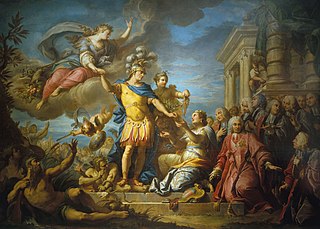
The 1748 Treaty of Aix-la-Chapelle, sometimes called the Treaty of Aachen, ended the War of the Austrian Succession, following a congress assembled on 24 April 1748 at the Free Imperial City of Aachen.
The Russo-Persian Wars or Russo-Iranian Wars were a series of conflicts between 1651 and 1828, concerning Persia and the Russian Empire. Russia and Persia fought these wars over disputed governance of territories and countries in the Caucasus. The main territories disputed were Aran, Georgia and Armenia, as well as much of Dagestan – generally referred to as Transcaucasia – and considered part of the Safavid Iran prior to the Russo-Persian Wars. Over the course of the five Russo-Persian Wars, the governance of these regions transferred between the two empires. Between the Second and Third Russo-Persian Wars, there was an interbellum period in which a number of treaties were drawn up between the Russian and the Persian Empires, as well as between both parties and the Ottoman Empire. Ottoman interest in these territories further complicated the wars, with both sides forming alliances with the Ottoman Empire at different points throughout the wars. Following the Treaty of Turkmenchay, which concluded the Fifth Russo-Persian War, Persia ceded much of its Transcaucasian territory to the Russian Empire.

Russo-Turkish wars or Russo-Ottoman wars were a series of twelve wars fought between the Russian Empire and the Ottoman Empire between the 16th and 20th centuries. It was one of the longest series of military conflicts in European history. Except for the war of 1710–11, as well as the Crimean War which is often treated as a separate event, the conflicts ended disastrously for the Ottoman Empire, which was undergoing a long period of stagnation and decline; conversely, they showcased the ascendancy of Russia as a European power after the modernization efforts of Peter the Great in the early 18th century.

The Treaty of the Pruth was signed on the banks of the river Prut between the Ottoman Empire and the Tsardom of Russia on 23 July 1711 ending the Russo-Turkish War of 1710–1711 with the assistance of Peter Shafirov. The treaty was a political victory for the Ottoman Empire.
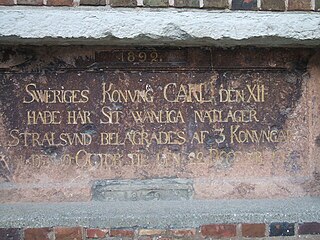
The siege of Stralsund was a battle during the Great Northern War. The Swedish Empire defended her Swedish Pomeranian port of Stralsund against a coalition of Denmark-Norway, the Electorate of Saxony and the Tsardom of Russia, which was joined by the Kingdom of Prussia during the siege.
The Treaty of Constantinople or Istanbul was signed on 13 July 1700 between the Tsardom of Russia and the Ottoman Empire. It ended the Russo-Turkish War of 1686-1700. Russian tsar Peter the Great secured possession of the Azov region and freed his forces to participate in the Great Northern War. The treaty was superseded by the Treaty of the Pruth in 1711, after the Ottoman Empire became involved in this war.

The Russian Empire was a vast empire that spanned most of northern Eurasia from its proclamation in November 1721 until its dissolution in March 1917. At its height in the late 19th century, it covered about 22,800,000 square kilometres (8,800,000 sq mi), roughly one-sixth of the world's landmass, making it the third-largest empire in history, behind only the British and Mongol empires. It also held colonies in North America between 1799 and 1867. The empire's 1897 census, the only one it conducted, found a population of 125.6 million with considerable ethnic, linguistic, religious, and socioeconomic diversity.

With the Capitulation of Estonia and Livonia in 1710 the Swedish dominions Estonia and Livonia were integrated into the Russian Empire following their conquest during the Great Northern War. The Livonian nobility and the city of Riga capitulated on 4 July (O.S.) / 15 July 1710 (N.S.), Pernau (Pärnu) in August, and the Estonian nobility and the city of Reval (Tallinn) on 29 September (O.S.) / 10 October (N.S.). Russia left the local institutions in place and confirmed the traditional privileges of the German nobles and burghers as was established in Privilegium Sigismundi Augusti, especially with respect to the Protestant faith. The land reform of the so-called reduction which had been introduced by the Swedish king Charles XI, and transformed many serfs to subjects of the Crown, was reversed.

Concluded on 9 October 1709, the Treaty of Thorn was an agreement signed in Thorn (Toruń) between Augustus the Strong of the Polish-Lithuanian Commonwealth and his counterpart, Peter the Great the Tsar of Russia. Through this agreement, the two parties revived an alliance from an earlier treaty between them in 1699, which their common rival Charles XII of Sweden had dismantled through the 1706 Treaty of Altranstädt. In the 1709 treaty, the two parties agreed to restore the Polish crown to Augustus among various other provisions with different implications for both parties and their respective nations. A close examination of the background to the agreement as well as the terms, implementation, and implications of the Treaty of Thorn underscores its significance in marking the Tsar’s and Russia’s ascendance into a powerful regional player in northeastern Europe.
Devlet II Giray (1648–1718) was Khan of the Crimean Khanate from 1699 to 1702 and from 1709 to 1713. He was the eldest son of Selim I Giray.

The emperor and autocrat of all Russia, also translated as emperor and autocrat of all the Russias, was the official title of the Russian monarch from 1721 to 1917.

The Treaty of Tsarskoye Selo also called (Mageskiftetraktakten) in Danish, was a territorial and dynastic treaty between the Russian Empire and Denmark–Norway. Signed on 1 June 1773, it transferred control of ducal Schleswig-Holstein to the Danish crown in return for Russian control of the County of Oldenburg and adjacent lands within the Holy Roman Empire. The treaty reduced the fragmentation of Danish territory and led to an alliance between Denmark–Norway and Russia that lasted into the Napoleonic Wars. It also made possible the construction of the Eider Canal, parts of which were later incorporated into the Kiel Canal.
References
- ↑ "ICRP Calendar" (PDF). Institute for Cultural Relations Policy .
- ↑ MacDougall, Philip (2022). The Great Anglo-Russian Naval Alliance of the Eighteenth Century and Beyond. Boydell & Brewer. ISBN 978-1-78327-668-4.
- ↑ Leonard, Carol S. (1993-03-22). Reform and Regicide: The Reign of Peter III of Russia. Indiana University Press. ISBN 978-0-253-11280-4.
- ↑ Kamenskiĭ, Aleksandr (2020). Catherine the Great: A Reference Guide to Her Life and Works. Rowman & Littlefield. ISBN 978-1-5381-3028-5.
- ↑ Crummey, Robert O. (2014-07-14). Aristocrats and Servitors: The Boyar Elite in Russia, 1613-1689. Princeton University Press. ISBN 978-1-4008-5369-4.
- ↑ Offord, Derek (2006-07-01). Journeys to a Graveyard: Perceptions of Europe in Classical Russian Travel Writing. Springer. ISBN 978-1-4020-3909-6.
![]() Media related to 1713 in Russia at Wikimedia Commons
Media related to 1713 in Russia at Wikimedia Commons